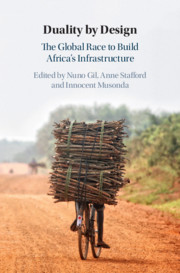Book contents
- Reviews
- Duality by Design
- Duality by Design
- Copyright page
- Contents
- Figures
- Tables
- Contributors
- Foreword
- Acknowledgements
- 1 Duality by Design: The Global Race to Build Africa’s Infrastructure
- Part I Mitigating Institutional Voids by Design
- Part II Exploiting Institutional Voids by Design
- 11 Kenya’s Madaraka Express: An Example of the Decisive Chinese Impulse for African Mega-Infrastructure Projects
- 12 No One-Size-Fits-All Organisational Solution: Learning from Railway Developments in South Africa and Ethiopia
- 13 Building Institutions or Capital Investment? Organisational Duality in the Pursuit of Socio-Economic Development
- Afterword
- Index
- References
12 - No One-Size-Fits-All Organisational Solution: Learning from Railway Developments in South Africa and Ethiopia
from Part II - Exploiting Institutional Voids by Design
Published online by Cambridge University Press: 14 November 2019
- Reviews
- Duality by Design
- Duality by Design
- Copyright page
- Contents
- Figures
- Tables
- Contributors
- Foreword
- Acknowledgements
- 1 Duality by Design: The Global Race to Build Africa’s Infrastructure
- Part I Mitigating Institutional Voids by Design
- Part II Exploiting Institutional Voids by Design
- 11 Kenya’s Madaraka Express: An Example of the Decisive Chinese Impulse for African Mega-Infrastructure Projects
- 12 No One-Size-Fits-All Organisational Solution: Learning from Railway Developments in South Africa and Ethiopia
- 13 Building Institutions or Capital Investment? Organisational Duality in the Pursuit of Socio-Economic Development
- Afterword
- Index
- References
Summary
Against the backdrop of an increasing demand for efficient, effective and sustainable new infrastructure developments in Africa, this study examines two rapid railway transportation projects to explore alternative ways of organising. The analysis focuses on the Gautrain railway system in South Africa and the Addis Ababa City Light Rail Transit (AA-LRT) system in Ethiopia. Adopting a comparative approach, we investigate how the two capital-intensive project organisations succeeded in overcoming system bottlenecks, and in dealing with complex interfaces with the institutional environment. Our focus is on the structures designed by the project promoter to acquire the necessary formal resources – finance, human capital, certification and land – and to manage the interdependency with the environment. We also investigate the extent to which the developments succeeded in creating broad value beyond the private value appropriated by the private firms involved in design, construction and operations. In agreement with organisation design literature, our analysis suggests the design of the governance structures is directly influenced by the political and sociocultural environment. Therefore, we argue, designing project organisations to deliver infrastructure in Africa is not a problem with a one-size-fits-all solution.
- Type
- Chapter
- Information
- Duality by DesignThe Global Race to Build Africa's Infrastructure, pp. 353 - 377Publisher: Cambridge University PressPrint publication year: 2019
References
- 1
- Cited by

